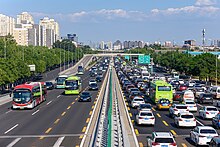
Back صناعة السيارات في الصين Arabic Автомобилна промишленост в КНР Bulgarian Geschichte der Automobilindustrie Chinas German صنعت خودروسازی چین Persian Kiinan autoteollisuus Finnish Industri otomotif di Tiongkok ID 中国の自動車産業 Japanese Indústria automotiva na China Portuguese Industria automobilelor în China Romanian Автомобильная промышленность КНР Russian

This article may require copy editing for grammar, style, cohesion, tone, or spelling. (May 2024) |
| Part of a series on the |
| History of science and technology in China |
|---|
 |
The automotive industry in mainland China has been the largest in the world measured by automobile unit production since 2008.[1][2] As of 2024[update], mainland China is also the world's largest automobile market both in terms of sales and ownership.
The Chinese automotive industry has seen significant developments and transformations over the years. While the period from 1949 to 1980 witnessed slow progress in the industry due to restricted competition and political instability during the Cultural Revolution, the landscape started to shift during the Chinese economic reform period, especially after the government's seventh five-year plan prioritized the domestic automobile manufacturing sector. Foreign investment and joint ventures played a crucial role in attracting foreign technology and capital into China. American Motors Corporation (AMC) and Volkswagen were among the early entrants, signing long-term contracts to produce vehicles in China. This led to the gradual localization of automotive components, and the strengthening of key local players such as SAIC, FAW, Dongfeng and Changan, collectively known as the "Big Four". The entry of China into the World Trade Organization (WTO) in 2001 further accelerated the growth of the automotive industry. Tariff reductions and increased competition led to a surge in car sales, with China becoming the largest auto producer globally since 2008.
In the 2020s, the automotive industry in mainland China has experienced a rise in market dominance by domestic manufacturers, with a growing focus on areas such as electric vehicle technology and advanced assisted driving systems. The maturation of technology and supply chains has also led foreign carmakers to seek partnerships with Chinese manufacturers. However, the industry also faced heightened scrutiny and restrictions from Western countries, partly due to the China–United States trade war.
In 2023, annual production of automobiles in China accounted for more than 32% of worldwide vehicle production, exceeding both that of the European Union and that of the United States and Japan combined.[3][4] Although the majority of vehicles produced in China are sold domestically, exports reached 3.11 million units in 2022, accounting for 11.5% of total production. This makes the country the world's second-largest car exporter.[5] In 2023, China overtook Japan and became the world largest car exporter.[6]
Automobile manufacturers in China mainly consists of local manufacturers and Sino-foreign joint ventures. Since 2018, the Chinese government began allowing foreign manufacturers to produce cars without forming joint venture with a local partner. The main industry group for the Chinese automotive industry is the China Association of Automobile Manufacturers (CAAM, Chinese: 中国汽车工业协会).
- ^ Marr, Kendra (2009-05-18). "China emerges as world's auto epicenter". NBC News. Retrieved 2024-05-16.
- ^ "Motoring ahead". The Economist. October 23, 2009. ISSN 0013-0613. Retrieved 2024-05-16.
- ^ "2023 statistics | www.oica.net". www.oica.net. Retrieved 2024-05-16.
- ^ "China Motor Vehicle Production, 1997 – 2024 | CEIC Data". www.ceicdata.com.cn. Retrieved 2024-05-16.
- ^ "China closes in on Japan after surpassing Germany in 2022 car exports". South China Morning Post. 2023-01-15. Retrieved 2023-01-28.
- ^ Hoskins, Peter (18 May 2023). "China overtakes Japan as world's top car exporter". BBC News.
© MMXXIII Rich X Search. We shall prevail. All rights reserved. Rich X Search